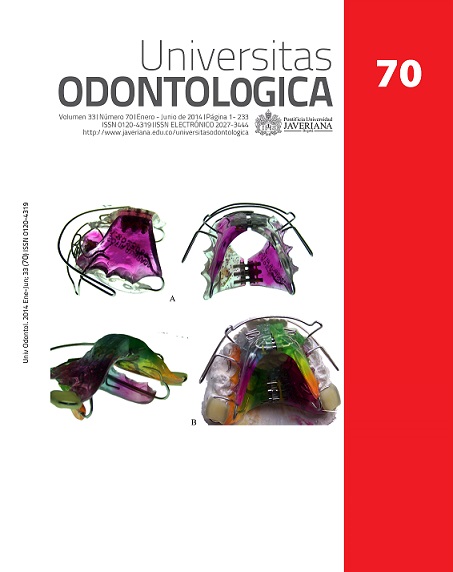Resumen
Propósito: Comparar el estado de maduración ósea en radiografías de perfil en una población colombiana con y sin labio y paladar fisurado por medio del análisis de maduración de vértebras cervicales (MVC). Métodos: Un examinador previamente calibrado (kappa = 0,76) evaluó el estado de MVC en 145 radiografías de perfil de individuos con y sin labio y paladar fisurado, con edades entre 7 y 18 años. De ellos 73 tenían labio y paladar fisurado y 72 no tenían fisura. Se realizó un análisis estadístico descriptivo e inferencial con la prueba de chi cuadrado (alfa = 0,05). Resultados: A los 7-9 años de edad, el mayor porcentaje de las vértebras cervicales se encontró en estadio CS1 y ninguna en CS5 y CS6. A los 10-12 años, la mayor frecuencia se encontró en CS4 y ninguno en CS6. A los 13-15 años, la mayor proporción estaba en CS4. A los 16-18 años, el mayor porcentaje se observó en CS5 y ninguno en CS1, CS2 o CS3. Al comparar el desarrollo de las vértebras cervicales entre los dos grupos, no se encontraron diferencias estadísticamente significativas (p = 0,8). Conclusión: El estado de maduración ósea en la población estudiada de individuos colombianos con y sin labio y paladar fisurado, por medio del análisis de MVC en radiografías de perfil, mostró resultados similares en los dos grupos. El pico máximo de crecimiento se presentó en el grupo de 10-15 años (CS3 y CS4).
PALABRAS CLAVE
labio y paladar fisurado; maduración de vértebras cervicales; crecimiento y desarrollo
Tiziano Baccetti, Lorenzo Franchi, James McNamara. The Cervical Vertebral Maduration (CVM ) Method for the Assessment of Optimal Treatment Timing in Dentofacial Orthopedics. Angle Orthod. 2002; 72(4): 316-23.
Tanner JM. Foetus into Man. London: Open Books Publ. LTD, 1978
Rajion ZA, Townsend GC, Netherway Dj, Anderson PJ, Yusof A, Hughes T, Shuaib IL, David Dj. Three-dimensional Computed Tomographic Analysis of the Cervical Spine in Unoperated Infants with Cleft Lip and Palate. Cleft palate craneofac J. 2006 ; 43(5): 513-8.
Franchi L, Baccetti T, McNamara JA Jr: Treatment and Posttreatment Effects of Acrylic Splint Herbst Appliance Therapy. Am J Orthod Dentofacial.Orthop 1999. 115:429-438.
Baccetti T, McGill JS, Franchi L, et al: Skeletal Effects of Early Treatment of Class III Malocclusion with Maxillary Expansion and Face-mask Therapy. Am J Orthod Dentofacial Orthop 1998.113:333-343.
Lamparsky DG. Skeletal age Assessment Utilizing Cervical Vertebrae. J Anat. 1975; 11(1): 49-68.
Maria T O´Reilly, Gary J Yanniello, Mandibular Growth Changes and Maturation of Cervical Vertebrae – A Longitudinal Cephalometric study. The Angle Orthodontist, 1988,58(2):179-84.
Sun L, Li WR, Cervical vertebral maturation of female children with orofacial clefts, Cleft Palate Craniofac J. 2013 Sep;50(5):535-41.
Sun L, Li WR. Cervical vertebral maturation of children with orofacial clefts. Cleft Palate Craniofac J. 2012 Nov;49(6):683-8.
Ceglia A. Indicadores de Maduración de la Edad ,Ósea, Dental y Morfológica. Revista Latinoamericana de Ortodoncia y Odontopediatria [Internet] 2005 mayo. Disponible en: http:// www.ortodoncia.ws
Bench R. Browth of the Vervical Vertebrae as Related Tongee, Face and the Venture Behaviore. Am J orthod. 1963; 3:183-214
Perinetti G, Contardo L, Gabrieli P, Baccetti T, Di Lenarda R. Diagnostic performance of dental maturity for identification of skeletal maturation phase. Eur J Orthod. 2012 ;34(4):487-92.
Baptista RS, Quaglio CL, Mourad LM, Hummel AD, Caetano CA, Ortolani CL, Pisa IT. A semi-automated method for bone age assessment using cervical vertebral maturation. Angle Orthod. 2012;82(4):658-62.
Rudman D, Davis T, Priest JH, Patterson JH, Kutner MH, Heymsfield SB, Bethel RA. Prevalence of growth hormone deficiency in children with cleft lip or palate. J Pediatr. 1978; 93:378–382.
Bowers EJ, Mayro RF, Whitaker LA, Pasquariello OS, LaRossa D, Randall P. General body growth in children with clefts of the lip, palate and craniofacial structure. Scand J Plast Reconst Surg.1987;21:7–14.
Zarate YA, Martin LJ, Hopkin RJ, Bender PL, Zhang X, Saal HM. Evaluation on growth in patients with isolated cleft lip and palate. Pediatrics. 2010; 125 (3) : 543-9.
Rózylo-Kalinowska I, Kolasa-Raczka A, Kalinowski P. Relationship Between Dental Age According to Demirjian and Cervical Vertebrae Maturity in Polish Children. Department of Dental and Maxillofacial Radiology. Eur J Orthod. 2011;33(1):75-83.
Balachandran G. Klippel-Feil Syndrome and Anterior Cervical Meningomyelocele: a Rare Case Report.AJNR Am J Neuroradiol. 2009;30(9): 130.
Kaban LB, Seldin EB, Kikinis R, Yeshwant K, Padwa BL, Troulis MJ. Clinical Application of Curvilinear Distraction Osteogenesis for Correction of Mandibular Deformities. J Oral Maxillofac Surg. 2009 ;67(5):996-1008.
Thompson DN, Slaney SF, Hall CM, Shaw D, Jones BM, Hayward RD. Congenital cervical spinal fusion: a study in Apert syndrome. Pediatr Neurosurg. 1996;25(1):20-7.
Esta revista científica se encuentra registrada bajo la licencia Creative Commons Reconocimiento 4.0 Internacional. Por lo tanto, esta obra se puede reproducir, distribuir y comunicar públicamente en formato digital, siempre que se reconozca el nombre de los autores y a la Pontificia Universidad Javeriana. Se permite citar, adaptar, transformar, autoarchivar, republicar y crear a partir del material, para cualquier finalidad (incluso comercial), siempre que se reconozca adecuadamente la autoría, se proporcione un enlace a la obra original y se indique si se han realizado cambios. La Pontificia Universidad Javeriana no retiene los derechos sobre las obras publicadas y los contenidos son responsabilidad exclusiva de los autores, quienes conservan sus derechos morales, intelectuales, de privacidad y publicidad.
El aval sobre la intervención de la obra (revisión, corrección de estilo, traducción, diagramación) y su posterior divulgación se otorga mediante una licencia de uso y no a través de una cesión de derechos, lo que representa que la revista y la Pontificia Universidad Javeriana se eximen de cualquier responsabilidad que se pueda derivar de una mala práctica ética por parte de los autores. En consecuencia de la protección brindada por la licencia de uso, la revista no se encuentra en la obligación de publicar retractaciones o modificar la información ya publicada, a no ser que la errata surja del proceso de gestión editorial. La publicación de contenidos en esta revista no representa regalías para los contribuyentes.


